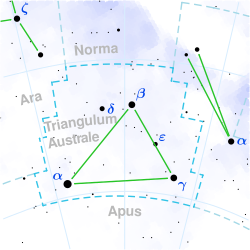Delta Trianguli Australis
| Observation data Epoch J2000.0 Equinox J2000.0 | |
|---|---|
| Constellation | Triangulum Australe |
| Right ascension | 16h 15m 26.26978s[1] |
| Declination | −63° 41′ 08.4492″[1] |
| Apparent magnitude (V) | 3.84±0.01[2] |
| Characteristics | |
| Spectral type | G2 Ib-IIa[3] |
| U−B color index | +0.87[4] |
| B−V color index | +1.10[4] |
| Astrometry | |
| Radial velocity (Rv) | −4.9±0.7[5] km/s |
| Proper motion (μ) | RA: +2.73 mas/yr[1] Dec.: −12.92 mas/yr[1] |
| Parallax (π) | 5.37 ± 0.17 mas[1] |
| Distance | 610 ± 20 ly (186 ± 6 pc) |
| Absolute magnitude (MV) | −2.49[6] |
| Details | |
| Mass | 6.51[7] M☉ |
| Radius | 53.6[8] R☉ |
| Luminosity | 1,210[9] L☉ |
| Surface gravity (log g) | 1.54[10] cgs |
| Temperature | 4,705±122[8] K |
| Metallicity [Fe/H] | −0.05[10] dex |
| Rotational velocity (v sin i) | 8.2±2[11] km/s |
| Other designations | |
| Database references | |
| SIMBAD | data |
Delta Trianguli Australis (Delta TrA), Latinized from δ Trianguli Australis, is a solitary,[14] yellow-hued star in the constellation Triangulum Australe. It has an apparent magnitude of 3.84,[2] making it readily visible to the naked eye under ideal conditions, Parallax measurements place the object at a distance of 606 light years (182 parsecs).[1] It has a heliocentric radial velocity of −4.9 km/s,[5] indicating that it is drifting towards the Solar System.
Delta TrA has a stellar classification of G2 Ib-IIa[3] — an evolved G-type star with a luminosity class intermediate between a low luminosity supergiant and a bright giant. At present it has 6.5 times the mass of the Sun[7] and has an enlarged radius of 53.6 R☉.[8] It radiates at 1,210 times the luminosity of the Sun[9] from its photosphere at an effective temperature of 4,705 K.[8] Delta TrA has an iron abundance 89% that of the Sun,[10] placing it around solar metallicity. It spins modestly with a projected rotational velocity of 8.2 km/s, which is high for stars of this type.[11]
References
[edit]- ^ a b c d e van Leeuwen, Floor (13 August 2007). "Validation of the new Hipparcos reduction". Astronomy & Astrophysics. 474 (2): 653–664. arXiv:0708.1752. Bibcode:2007A&A...474..653V. doi:10.1051/0004-6361:20078357. eISSN 1432-0746. ISSN 0004-6361. Hipparcos record for this source at VizieR.
- ^ a b Høg, E.; Fabricius, C.; Makarov, V. V.; Urban, S.; Corbin, T.; Wycoff, G.; Bastian, U.; Schwekendiek, P.; Wicenec, A. (March 2000). "The Tycho-2 catalogue of the 2.5 million brightest stars". Astronomy and Astrophysics. 355: L27–L30. Bibcode:2000A&A...355L..27H. ISSN 0004-6361.
- ^ a b Keenan, Philip C.; McNeil, Raymond C. (October 1989). "The Perkins catalog of revised MK types for the cooler stars". The Astrophysical Journal Supplement Series. 71: 245. Bibcode:1989ApJS...71..245K. doi:10.1086/191373. eISSN 1538-4365. ISSN 0067-0049.
- ^ a b Cousins, A. W. J. (1971). "Photometric standard stars". Royal Observatory Annals. 7. Bibcode:1971ROAn....7.....C.
- ^ a b Gontcharov, G. A. (November 2006). "Pulkovo Compilation of Radial Velocities for 35 495 Hipparcos stars in a common system". Astronomy Letters. 32 (11): 759–771. arXiv:1606.08053. Bibcode:2006AstL...32..759G. doi:10.1134/S1063773706110065. eISSN 1562-6873. ISSN 1063-7737. S2CID 119231169.
- ^ Anderson, E.; Francis, Ch. (May 2012). "XHIP: An extended hipparcos compilation". Astronomy Letters. 38 (5): 331–346. arXiv:1108.4971. Bibcode:2012AstL...38..331A. doi:10.1134/S1063773712050015. eISSN 1562-6873. ISSN 1063-7737. S2CID 119257644.
- ^ a b Kervella, Pierre; Arenou, Frédéric; Thévenin, Frédéric (20 December 2021). "Stellar and substellar companions from Gaia EDR3". Astronomy & Astrophysics. 657: A7. arXiv:2109.10912. Bibcode:2022A&A...657A...7K. doi:10.1051/0004-6361/202142146. eISSN 1432-0746. ISSN 0004-6361.
- ^ a b c d Stassun, Keivan G.; et al. (9 September 2019). "The Revised TESS Input Catalog and Candidate Target List". The Astronomical Journal. 158 (4): 138. arXiv:1905.10694. Bibcode:2019AJ....158..138S. doi:10.3847/1538-3881/ab3467. eISSN 1538-3881.
- ^ a b McDonald, I.; Zijlstra, A. A.; Boyer, M. L. (21 November 2012). "Fundamental parameters and infrared excesses of Hipparcos stars: Parameters and IR excesses from Hipparcos". Monthly Notices of the Royal Astronomical Society. 427 (1): 343–357. arXiv:1208.2037. Bibcode:2012MNRAS.427..343M. doi:10.1111/j.1365-2966.2012.21873.x. ISSN 0035-8711.
- ^ a b c Luck, R. Earle (2 May 2014). "Parameters and Abundances in Luminous Stars". The Astronomical Journal. 147 (6): 137. Bibcode:2014AJ....147..137L. doi:10.1088/0004-6256/147/6/137. eISSN 1538-3881. ISSN 0004-6256.
- ^ a b De Medeiros, J. R.; Alves, S.; Udry, S.; Andersen, J.; Nordström, B.; Mayor, M. (January 2014). "A catalog of rotational and radial velocities for evolved stars". Astronomy & Astrophysics. 561: A126. arXiv:1312.3474. Bibcode:2014A&A...561A.126D. doi:10.1051/0004-6361/201220762. eISSN 1432-0746. ISSN 0004-6361.
- ^ Gould, Benjamin Apthorp (1878). "Uranometria Argentina : brillantez y posicion de las estrellas fijas, hasta la septima magnitud, comprendidas dentro de cien grados del polo austral : con atlas". Resultados del Observatorio Nacional Argentino. 1. Bibcode:1879RNAO....1.....G.
- ^ "del TrA". SIMBAD. Centre de données astronomiques de Strasbourg. Retrieved August 15, 2022.
- ^ Eggleton, P. P.; Tokovinin, A. A. (September 2008), "A catalogue of multiplicity among bright stellar systems", Monthly Notices of the Royal Astronomical Society, 389 (2): 869–879, arXiv:0806.2878, Bibcode:2008MNRAS.389..869E, doi:10.1111/j.1365-2966.2008.13596.x, S2CID 14878976.

